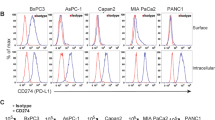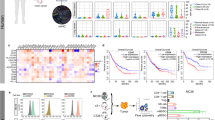Abstract
Purpose
Treatment-associated upregulation of suppressive checkpoints and a lack of costimulatory signals compromise the antitumor efficacy of oncolytic virus immunotherapy. Therefore, we aimed to identify highly effective therapeutic targets to provide a proof-of-principle for immune checkpoint together with oncolytic virus-mediated viro-immunotherapy for cancer.
Methods
A fusion protein containing both the extracellular domain of programmed death-1 (PD-1) and the poliovirus receptor (PVR) was designed. Next, the corresponding expression fragment was inserted into the genome of a replication-competent adenovirus to generate Ad5sPD1PVR. The infection, expression, replication and oncolysis of Ad5sPD1PVR were investigated in hepatocellular carcinoma (HCC) cell lines. Immune activation and the antitumor efficacy of Ad5sPD1PVR were examined in HCC tumor models including a humanized immunocompetent mouse model.
Results
Ad5sPD1PVR effectively infected and replicated in HCC cells and secreted sPD1PVR. In a H22 ascitic HCC mouse model, intraperitoneal injection of Ad5sPD1PVR markedly recruited lymphocytes and activated antitumor immune responses. Ad5sPD1PVR exerted a profound antitumor effect on ascitic HCC. Furthermore, we found that Ad5sPD1PVR-H expressing sPD1PVR of human origin exhibited potent antitumor effects in a HCC humanized mouse model. We also found that CD8+ T cells mediated the antitumor effects and long-term tumor-specific immune surveillance induced by Ad5sPD1PVR. Finally, when combined with fludarabine, the antitumor efficacy of Ad5sPD1PVR was found to be further improved in the ascitic HCC model.
Conclusions
From our data we conclude that the newly designed recombinant Ad5sPD1PVR virus significantly enhances CD8+ T cell-mediated antitumor efficacy with long-term tumor-specific immune surveillance in hepatocellular carcinoma, and that fludarabine is a promising therapeutic partner for Ad5sPD1PVR.





Similar content being viewed by others
Availability of data and material
All data and materials generated during and/or analysed during the current study are available from the corresponding author upon reasonable request.
References
J.M. Llovet, R.K. Kelley, A. Villanueva, A.G. Singal, E. Pikarsky, S. Roayaie, R. Lencioni, K. Koike, J. Zucman-Rossi, R.S. Finn, Hepatocellular carcinoma. Nat Rev Dis Primers 7, 6 (2021)
J.C. Nault, A.L. Cheng, B. Sangro, J.M. Llovet, Milestones in the pathogenesis and management of primary liver cancer. J Hepatol 72, 209–214 (2020)
Z. Yin, X. Li, Immunotherapy for hepatocellular carcinoma. Cancer Lett 470, 8–17 (2020)
S. Vilarinho, T.H. Taddei, New frontier in liver cancer treatment: oncolytic viral therapy. Hepatology 59, 343–346 (2014)
J. Altomonte, Liver cancer: Sensitizing hepatocellular carcinoma to oncolytic virus therapy. Nat Rev Gastroenterol Hepatol 15, 8–10 (2018)
M.J. Smyth, S.F. Ngiow, A. Ribas, M.W. Teng, Combination cancer immunotherapies tailored to the tumour microenvironment. Nat Rev Clin Oncol 13, 143–158 (2016)
J. Li, Y. Lee, Y. Li, Y. Jiang, H. Lu, W. Zang, X. Zhao, L. Liu, Y. Chen, H. Tan, Z. Yang, M.Q. Zhang, T.W. Mak, L. Ni and C. Dong, Co-inhibitory molecule B7 superfamily member 1 expressed by tumor-infiltrating myeloid cells induces dysfunction of anti-tumor CD8(+) T cells, Immunity 48, 773–786 e775 (2018)
B.A. Helmink, P.O. Gaudreau, J.A. Wargo, Immune checkpoint blockade across the cancer care continuum. Immunity 48, 1077–1080 (2018)
M.M. Soldevilla, H. Villanueva, D. Meraviglia-Crivelli, A.P. Menon, M. Ruiz, J. Cebollero, M. Villalba, B. Moreno, T. Lozano, D. Llopiz, A. Pejenaute, P. Sarobe, F. Pastor, ICOS costimulation at the tumor site in combination with CTLA-4 blockade therapy elicits strong tumor immunity. Mol Ther 27, 1878–1891 (2019)
Y. Kong, L. Zhu, T.D. Schell, J. Zhang, D.F. Claxton, W.C. Ehmann, W.B. Rybka, M.R. George, H. Zeng, H. Zheng, T-cell immunoglobulin and ITIM domain (TIGIT) associates with CD8+ T-cell exhaustion and poor clinical outcome in AML patients. Clin Cancer Res 22, 3057–3066 (2016)
X. Yu, K. Harden, L.C. Gonzalez, M. Francesco, E. Chiang, B. Irving, I. Tom, S. Ivelja, C.J. Refino, H. Clark, D. Eaton, J.L. Grogan, The surface protein TIGIT suppresses T cell activation by promoting the generation of mature immunoregulatory dendritic cells. Nat Immunol 10, 48–57 (2009)
N.A. Manieri, E.Y. Chiang, J.L. Grogan, TIGIT: A key inhibitor of the cancer immunity cycle. Trends Immunol 38, 20–28 (2017)
J.M. Chauvin, O. Pagliano, J. Fourcade, Z. Sun, H. Wang, C. Sander, J.M. Kirkwood, T.H. Chen, M. Maurer, A.J. Korman, H.M. Zarour, TIGIT and PD-1 impair tumor antigen-specific CD8(+) T cells in melanoma patients. J Clin Invest 125, 2046–2058 (2015)
R.J. Johnston, L. Comps-Agrar, J. Hackney, X. Yu, M. Huseni, Y. Yang, S. Park, V. Javinal, H. Chiu, B. Irving, D.L. Eaton, J.L. Grogan, The immunoreceptor TIGIT regulates antitumor and antiviral CD8(+) T cell effector function. Cancer Cell 26, 923–937 (2014)
F.S. Hodi, S.J. O’Day, D.F. McDermott, R.W. Weber, J.A. Sosman, J.B. Haanen, R. Gonzalez, C. Robert, D. Schadendorf, J.C. Hassel, W. Akerley, A.J. van den Eertwegh, J. Lutzky, P. Lorigan, J.M. Vaubel, G.P. Linette, D. Hogg, C.H. Ottensmeier, C. Lebbe, C. Peschel, I. Quirt, J.I. Clark, J.D. Wolchok, J.S. Weber, J. Tian, M.J. Yellin, G.M. Nichol, A. Hoos, W.J. Urba, Improved survival with ipilimumab in patients with metastatic melanoma. N Engl J Med 363, 711–723 (2010)
S.L. Topalian, F.S. Hodi, J.R. Brahmer, S.N. Gettinger, D.C. Smith, D.F. McDermott, J.D. Powderly, R.D. Carvajal, J.A. Sosman, M.B. Atkins, P.D. Leming, D.R. Spigel, S.J. Antonia, L. Horn, C.G. Drake, D.M. Pardoll, L. Chen, W.H. Sharfman, R.A. Anders, J.M. Taube, T.L. McMiller, H. Xu, A.J. Korman, M. Jure-Kunkel, S. Agrawal, D. McDonald, G.D. Kollia, A. Gupta, J.M. Wigginton, M. Sznol, Safety, activity, and immune correlates of anti-PD-1 antibody in cancer. N Engl J Med 366, 2443–2454 (2012)
D. Zamarin, R.B. Holmgaard, S.K. Subudhi, J.S. Park, M. Mansour, P. Palese, T. Merghoub, J.D. Wolchok and J.P. Allison, Localized oncolytic virotherapy overcomes systemic tumor resistance to immune checkpoint blockade immunotherapy, Sci Transl Med 6, 226ra232 (2014)
L. Chen, X. Han, Anti-PD-1/PD-L1 therapy of human cancer: past, present, and future. J Clin Invest 125, 3384–3391 (2015)
K. Harrington, D.J. Freeman, B. Kelly, J. Harper, J.C. Soria, Optimizing oncolytic virotherapy in cancer treatment. Nat Rev Drug Discov 18, 689–706 (2019)
M.A. Postow, Managing immune checkpoint-blocking antibody side effects, Am Soc Clin Oncol Educ Book, 76–83 (2015)
J. Naidoo, D.B. Page, B.T. Li, L.C. Connell, K. Schindler, M.E. Lacouture, M.A. Postow, J.D. Wolchok, Toxicities of the anti-PD-1 and anti-PD-L1 immune checkpoint antibodies. Ann Oncol 27, 1362 (2016)
J.A. Marin-Acevedo, R.M. Chirila, R.S. Dronca, Immune checkpoint inhibitor toxicities. Mayo Clin Proc 94, 1321–1329 (2019)
N. Woller, E. Gurlevik, B. Fleischmann-Mundt, A. Schumacher, S. Knocke, A.M. Kloos, M. Saborowski, R. Geffers, M.P. Manns, T.C. Wirth, S. Kubicka, F. Kuhnel, Viral infection of tumors overcomes resistance to PD-1-immunotherapy by broadening neoantigenome-directed T-cell responses. Mol Ther 23, 1630–1640 (2015)
R.R. Ji, S.D. Chasalow, L. Wang, O. Hamid, H. Schmidt, J. Cogswell, S. Alaparthy, D. Berman, M. Jure-Kunkel, N.O. Siemers, J.R. Jackson, V. Shahabi, An immune-active tumor microenvironment favors clinical response to ipilimumab. Cancer Immunol Immunother 61, 1019–1031 (2012)
S. Spranger, R.M. Spaapen, Y. Zha, J. Williams, Y. Meng, T.T. Ha and T.F. Gajewski, Up-regulation of PD-L1, IDO, and T(regs) in the melanoma tumor microenvironment is driven by CD8(+) T cells, Sci Transl Med 5, 200ra116 (2013)
S. Gujar, J.G. Pol, Y. Kim, P.W. Lee, G. Kroemer, Antitumor benefits of antiviral immunity: An underappreciated aspect of oncolytic virotherapies. Trends Immunol 39, 209–221 (2018)
M.C. Perez, J.T. Miura, S.M.H. Naqvi, Y. Kim, A. Holstein, D. Lee, A.A. Sarnaik, J.S. Zager, Talimogene laherparepvec (TVEC) for the treatment of advanced melanoma: A single-institution experience. Ann Surg Oncol 25, 3960–3965 (2018)
T.D. de Gruijl, A.B. Janssen, V.W. van Beusechem, Arming oncolytic viruses to leverage antitumor immunity. Expert Opin Biol Ther 15, 959–971 (2015)
M.Y. Bartee, K.M. Dunlap, E. Bartee, Tumor-localized secretion of soluble PD1 enhances oncolytic virotherapy. Cancer Res 77, 2952–2963 (2017)
S. Parviainen, M. Ahonen, I. Diaconu, A. Kipar, M. Siurala, M. Vaha-Koskela, A. Kanerva, V. Cerullo, A. Hemminki, GMCSF-armed vaccinia virus induces an antitumor immune response. Int J Cancer 136, 1065–1072 (2015)
Y.S. Lee, J.H. Kim, K.J. Choi, I.K. Choi, H. Kim, S. Cho, B.C. Cho, C.O. Yun, Enhanced antitumor effect of oncolytic adenovirus expressing interleukin-12 and B7–1 in an immunocompetent murine model. Clin Cancer Res 12, 5859–5868 (2006)
F. Yu, X. Wang, Z.S. Guo, D.L. Bartlett, S.M. Gottschalk, X.T. Song, T-cell engager-armed oncolytic vaccinia virus significantly enhances antitumor therapy. Mol Ther 22, 102–111 (2014)
T. Speck, J.P.W. Heidbuechel, R. Veinalde, D. Jaeger, C. von Kalle, C.R. Ball, G. Ungerechts, C.E. Engeland, Targeted BiTE expression by an oncolytic vector augments therapeutic efficacy against solid tumors. Clin Cancer Res 24, 2128–2137 (2018)
C.J. LaRocca, J. Han, T. Gavrikova, L. Armstrong, A.R. Oliveira, R. Shanley, S.M. Vickers, M. Yamamoto, J. Davydova, Oncolytic adenovirus expressing interferon alpha in a syngeneic Syrian hamster model for the treatment of pancreatic cancer. Surgery 157, 888–898 (2015)
K. Twumasi-Boateng, J.L. Pettigrew, Y.Y.E. Kwok, J.C. Bell, B.H. Nelson, Oncolytic viruses as engineering platforms for combination immunotherapy. Nat Rev Cancer 18, 419–432 (2018)
Y. Zhang, H. Zhang, M. Wei, T. Mou, T. Shi, Y. Ma, X. Cai, Y. Li, J. Dong, J. Wei, Recombinant adenovirus expressing a soluble fusion protein PD-1/CD137L subverts the suppression of CD8(+) T cells in HCC. Mol Ther 27, 1906–1918 (2019)
J. Niemann, F. Kuhnel, Oncolytic viruses: adenoviruses. Virus Genes 53, 700–706 (2017)
H. Zhang, Y. Zhang, J. Dong, B. Li, C. Xu, M. Wei, J. Wu, J. Wei, Recombinant oncolytic adenovirus expressing a soluble PVR elicits long-term antitumor immune surveillance. Mol Ther Oncolytics 20, 12–22 (2021)
U. Hegde, A. Chhabra, S. Chattopadhyay, R. Das, S. Ray, N.G. Chakraborty, Presence of low dose of fludarabine in cultures blocks regulatory T cell expansion and maintains tumor-specific cytotoxic T lymphocyte activity generated with peripheral blood lymphocytes. Pathobiology 75, 200–208 (2008)
G. Meng, Z. Fei, M. Fang, B. Li, A. Chen, C. Xu, M. Xia, D. Yu, J. Wei, Fludarabine as an adjuvant improves Newcastle Disease Virus-mediated antitumor immunity in hepatocellular carcinoma. Mol Ther Oncolytics 13, 22–34 (2019)
Acknowledgements
We thank the Translational Medicine Core Facilities of Nanjing University for instrumental support.
Funding
This work was funded by the National Natural Science Foundation of China (81773255, 81972888, 81700037 and 81472820) and the Primary Research & Development Plan of Jiangsu Province (BE2018701).
Author information
Authors and Affiliations
Contributions
J. WEI conceived and designed the study. J. WEI and J. WU supervised the project. H.Z., Y.Z. and J.D. performed the experiments and analyzed the data. H.Z., J. WU and J. WEI wrote the manuscript. All authors read and approved the final manuscript.
Corresponding authors
Ethics declarations
Competing interests
The authors declare no potential conflicts of interest.
Ethics approval and consent to participate
All animal experiments were conducted with approval of the Ethics Committee of Nanjing University Medical School. Animal welfare was closely monitored in accordance with the Guide for the Care and Use of Laboratory Animals of the National Institutes of Health.
Consent for publication
No consent was involved in this publication.
Additional information
Publisher's Note
Springer Nature remains neutral with regard to jurisdictional claims in published maps and institutional affiliations.
Supplementary Information
Below is the link to the electronic supplementary material.
Rights and permissions
About this article
Cite this article
Zhang, H., Zhang, Y., Dong, J. et al. Recombinant adenovirus expressing the fusion protein PD1PVR improves CD8+ T cell-mediated antitumor efficacy with long-term tumor-specific immune surveillance in hepatocellular carcinoma. Cell Oncol. 44, 1243–1255 (2021). https://doi.org/10.1007/s13402-021-00633-w
Accepted:
Published:
Issue Date:
DOI: https://doi.org/10.1007/s13402-021-00633-w




